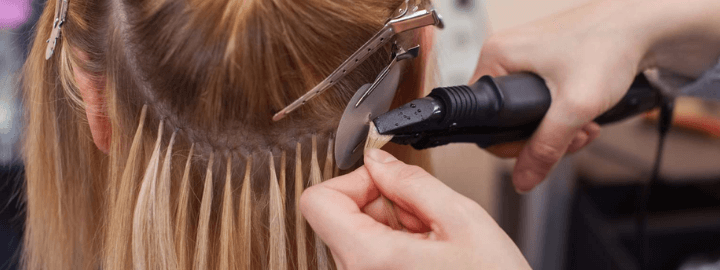One contentious term has been sparking controversies among women recently. And that’s none other than permanent hair extensions.
Is it a new type of extensions storming the market? Well, it’s nothing out of the ordinary but a way of categorizing long-lasting hair extensions.
As an extensions specialist, I’m here to talk about permanent extensions.
You’re going to learn today what you can have in your hair the longest. At the same time, you exude glamour and fuller hair.
What Are Permanent Hair Extensions?
Permanent hair extensions are hair extensions you can put on anywhere from 2 to 6 months. Further, if not worn a consecutive number of times, they can go for over a year. And when they clock up the duration of service, they need replacement. Or proper maintenance to last a little longer before complete removal.

From a broader perspective, hair extensions are either permanent or temporary. On the other hand, temporary extensions can not last more than a day or a week on your hair.
Types of Permanent Hair Extensions
Some may go to the extent of imagining permanent extensions are hair implants. Sorry to dismiss this line of thought. They’re the normal kind of extensions you’ve heard of before. These are tape-in, micro-ring, sew-in, hot fusion, and hand-tied extensions.
Tape-in Hair Extensions
Tape-in extensions are one of the lightweight and least damaging hair extensions. The construction of tape-ins is a 2-4 inch panel of hair weft attached to removable tapes on one end.
These transparent tapes are reinforced with an adhesive that bonds the hair to your own hair.
Basically, tape-in extensions applications are based on the sandwich concept. A small section of your hair lies between one weft on the top and another beneath.
They take about 45 min to an hour to apply. Besides, one tape-in installation lasts 8 weeks before replacing and repositioning the tapes.

Sew-in Hair Extensions
These are the extensions people commonly refer to as “weave”. Sew-in hair extensions are braided or braidless extensions. Both involve the looping of thread on a sew-able hair base.
The braided type requires braiding down the hair to form a base where the hair weft is threaded. You may have them in your hair for up to 10 weeks when the braids start loosening.
However, the braids may prolong longer, depending on your braids’ maintenance.
To avoid the pain associated with braids, braidless sew-ins include beaded hair sections.
That provides an anchorage track for securing the hairpieces instead of braids. The beads loosen the grip between 6 to 10 weeks and require moving up and re-clamping down.

Micro Ring Hair Extensions
The hairpieces, in this case, have been pre-bonded to a polymerized keratin I-tip. You might have heard of stick tip; that’s an alternative description for I-tip.
The installation depends on small rings for the extensions to bear the name micro ring extensions.
Your hair is inserted through the ring, followed by the tip of the strands of the extension. Then the ring, with its components, is clamped down to secure the extensions to your hair. It needs no glue, tape, or heat application.
The lifespan of a single installation is 9-12 weeks. The rings stay in one position on your hair, but your hair keeps growing. And that means the rings are delocalized over time and will need repositioning.

Hand-tied Hair Extensions
The method of application of hand-tied extensions is similar to the sew-in technique. These extensions are 11-12 inches of hair wefts.
First, you separate your hair into tiny sections and pull them through silicone beads. Then your stylist fastens the wefts against the beads. It’s a safe way of avoiding painful cornrowed braids and heat damage.
It’s also a good idea to gain massive hair volume without visiting the salon often. You’ll see the salon entrance after 8-12 weeks if you have them in today.

Hot Fusion Hair Extensions
Hot fusion hair extensions are the most eccentric one that incorporate heat during installation. The hair comes as individual strands with a square tip on one end.That tip is pure keratin protein in a solid form that works as the bonding material when melted with a heating gun. [1]
Like micro ring extensions, your hairstylist sections your hair in rows from the back, moving upwards. From there, the extensions get fused strand by strand by melting and shaping the keratin flat.
Don’t ever install them on your own at home, as they can turn out the most damaging hair extensions. However, the installations are time-consuming, taking even more than three hours.
The upside is that they endure the longest wear, lasting 12-24 weeks. It comes to a point they move too down with your ever-growing hair and compel you to go for a thorough salon retouch.

Pros of Permanent Hair Extensions
The question that pops up now is what benefit you amass from permanent extensions. For the sake of starters, permanent hair extensions have these advantages.
Last Longer
It’s with no doubt permanent extensions lessen hair expenses with their durability. It’s a money-saving tactic that reduces salon visits compared to temporary extensions.
They take you for months, more especially nothing less than two months. If you do not meet the expected lifespan, something is amiss with your care routine.
More Stable
The stability of the attachment points depends on the technique of installation. For instance, sew-ins involve threading through the braids or against the beads.
With threading, it’s hard for the hair extensions to get off your head. Therefore, the sew-ins cannot be on the same level as clip-ins as the anchorage is quite loose. If the clips slide off, the extensions will be out partially or wholly.

Versatile
The wide assortment of colors gives the flexibility to add one solid color to your hair. Or you can mix different colors if you choose individual-stranded extensions.
Additionally, permanent extensions allow you to switch from one hairstyle to another. You can work between high/low ponytail, side part, middle part, or high/low bun, etc.
Sleep in them
Sleeping with hair extensions works well as long as you set up braids or a loose ponytail. Moreover, you should better place your head on a soft surface like a satin pillow. Hair damage will be minimal, unlike temporary extensions removed before sleeping.
Cons of Permanent Hair Extensions
Even permanent extensions have their downsides apart from the benefits. It would help scrutinize them because they’ll help make a well-informed decision.
Expensive
Spending on a small budget is out of the question if you plan to wear permanent extensions. Be ready to spend $1000 or more on purchasing and installing them, as most are labor-intensive.
But they can cost as low as $200. You should be careful because such charges may link you to unprofessional stylists.
Itchy
Long periods of wearing permanent extensions lead to dirty natural hair beneath. The next thing you start scratching your head like no man’s business. This discomfort is due to the excessive build-up of hair products as time goes by.
And that indicates it’s time to wash your hair.
Sometimes, the itchiness may come about in the first week after installation. If this happens, the itchy feeling stems from scalp reactions with the tape or keratin bonds. If not, your hairstylist fixed the extensions too tightly, and they’re taking time to loosen.

Damage your Hair
It’s easy for permanent hair extensions to ruin your hair if you place them in your hair by yourself. These extensions are not the type you save up by avoiding the input of a seasonal hairstylist.
Such as bonded extensions, you are prone to improper installation or application of destructive heat. On top of that, you will face extreme hair breakage if you become reckless with their care.
FAQs about Permanent Hair Extensions
What are the best permanent hair extensions for short hair?
Whether fusion, tape-in, hand-tied, or micro-ring, any permanent extensions are good for short hair. And the meaningful transformation for short hair is obviously greater length. Yet all permanent extensions can offer that.
What are the best permanent hair extensions for thin hair?
Since thin hair is delicate and susceptible to breaking, tape-in extensions suit best. They’re ultra-light when sandwiching your hair, exerting little weight on thin hair.
But you can wear any other type of permanent extension. That’s provided the number of strands/wefts does not weigh down your natural thin hair.
Which hair extensions are most permanent?
Bonded, otherwise named hot fusion, hair extensions tend to last the longest. The method they’re melted and bonded to your hair strands gives the tightest grip. They stay healthy and beautiful for 12-24 weeks.
Are permanent hair extensions worth it?
Why not! They are undoubtedly workable for women who dislike frequent salon appointments. The greatest perk is that they stay in your hair for long, deeming an economic investment. They cut off the expenses you could have incurred if you visited the salon now and then.





